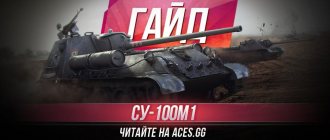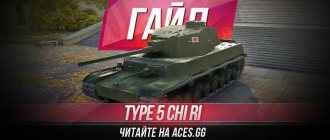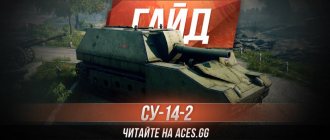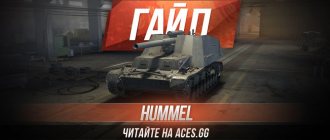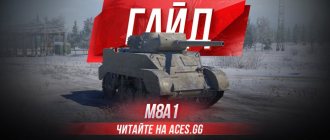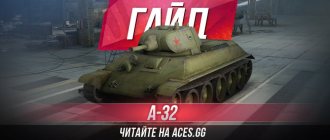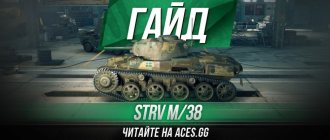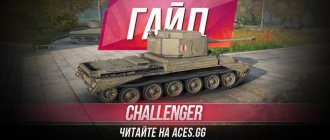Hello to all fans of tank battles and welcome to aces.gg! Our guest today was a rather interesting and somewhat unique vehicle, a Soviet premium tank destroyer of the seventh level - this is the ISU-122S guide
.
This car is part of the famous “Berlin Four”, which means that among the notable things it got a unique camouflage and two masterpiece logs on the body. In general, ISU-122С World of Tanks
It is quite similar to its cousin, the ISU-152, but there are more than enough differences, so you need to get to know this self-propelled gun better, especially if you are going to buy it.
Yes, by the way, buy ISU-122S
It just won’t happen, but everyone has the opportunity. Usually, all Berlin Four tanks begin to be sold on the eve of May 9, so be careful closer to this significant date.
TTX ISU-122S
Enough ranting, let's get to know our guests, and we'll start with the ISU-122S review
has a very meager, some pitiful 350 meters and besides this we have a typically small margin of safety, not much different from most PT-7s.
In terms of survivability, this device also cannot be called a bastion of reliability and safety. The fact is that the ISU-122S has characteristics
reservations from the frontal projection, in almost all planes, are equal to 100-116 millimeters, all due to the lack of slopes. This means that landmines with full damage will rarely hit us, but everything else will be able to cause damage to us without any problems.
However, in the forehead there is a Soviet tank ISU-122S
It has a really huge gun mantlet and it can hold back shots of even the ninth level with proper luck. The fact is that the shielded part is rounded, due to which the adjustment of the mask varies from 100 to 207 millimeters, followed by the main armor.
As for the sides, as expected, from the side view of the ISU-122S WoT tank destroyer
it is much worse protected and turning broadside towards the enemy is strictly contraindicated. In addition, the situation is aggravated by the large dimensions of the vehicle, due to which it is not only easier to hit, but also our camouflage coefficient suffers.
But despite its large dimensions and heavy weight, this Soviet self-propelled gun will please its owner with very decent mobility. Maximum speed ISU-122S tank World of Tanks
I received a good one, the dynamics are also at the level and only the maneuverability is a complaint, that is, it will not be so difficult to spin you.
Description of the design[edit | edit code]
The ISU-122 had the same layout as all other serial Soviet self-propelled guns of that time (with the exception of the SU-76). The fully armored hull was divided into two parts. The crew, gun and ammunition were located in front in the armored cabin, which combined the fighting compartment and the control compartment. The engine and transmission were installed at the rear of the vehicle.
Armored hull and deckhouse[edit | edit code]
The armored body of the self-propelled gun was welded from rolled armor plates with a thickness of 90, 75, 60, 30 and 20 mm. On the vehicles of the first modifications, the frontal part of the hull was an armor casting; Subsequently, as more resistant rolled armor became available, the design of the frontal part of the hull was changed to welded. Armor protection is differentiated, anti-ballistic. The armor plates of the wheelhouse were installed at rational angles of inclination. The main armament, the 121.92-mm A-19S cannon, was mounted in a frame-type installation to the right of the center line of the vehicle. The gun's recoil devices were protected by a fixed cast armor casing and a movable cast armor mask, which also served as a balancing element.
Three crew members were located to the left of the gun: in front was the driver, then the gunner, and behind was the loader. The vehicle commander and the castle commander were located to the right of the gun. If the crew consisted of four people, the functions of the loader were performed by the castle. The freed up space could be used to accommodate additional ammunition. The crew entered and exited through a rectangular double-leaf hatch at the junction of the roof and rear sheets of the armored cabin and through a round hatch to the right of the gun. The round hatch to the left of the gun was not intended for the crew to get in and out; it was required to bring the panoramic sight extension out. The hull also had a bottom hatch for emergency escape by the crew of the self-propelled gun and a number of small hatches for loading ammunition, access to the necks of the fuel tanks, and other components and assemblies of the vehicle.
Weapons[edit | edit code]
The main armament of the ISU-122 was the A-19S cannon of 121.92 mm caliber. The brand and type of gun varied depending on the modification and time of production of the self-propelled gun:
- ISU-122 of early production (before May 1944) were armed with a slightly modified 122-mm cannon mod. 1931/37 The changes concerned moving the gun controls to one side for ease of aiming, equipping its breech with a receiver tray for ease of loading and installing the electric trigger. The piston bolt is identical to the towed gun. The gun modified in this way was designated A-19C.
- The ISU-122 produced in May 1944 onwards was equipped with a largely modified 122-mm cannon, which no longer had interchangeable barrels with the A-19 and A-19C. This version of the gun was called the 122-mm self-propelled gun mod.
1931/44 . The shutter did not undergo significant changes and remained piston.
The gun was mounted in a frame on the front armor plate of the wheelhouse and had vertical aiming angles from -3° to +22°, the horizontal aiming sector was 10°. The height of the firing line was 1.79 m; direct shot range - 1000-1200 m at a target height of 2.5-3 m, direct fire range - 5 km, maximum firing range - 14.3 km. The shot was fired using an electric or manual mechanical trigger.
The gun's ammunition capacity was 30 rounds of separate loading. The shells were placed along both sides of the cabin, the charges were placed there, as well as on the bottom of the fighting compartment and on the rear wall of the cabin. Compared to the range of ammunition for the A-19 towed guns, the ISU-122 ammunition was significantly less diverse. It included:
- armor-piercing tracer sharp-headed projectile BR-471 weighing 25 kg; initial speed 792-800 m/s;
- high-explosive fragmentation cannon grenade OF-471 or OF-471N of the same mass and with the same initial speed when fully charged.
Instead of BR-471 armor-piercing tracer shells, blunt-headed armor-piercing tracer shells with a BR-471B ballistic tip could be used (from the beginning of 1945).
To destroy reinforced concrete bunkers, the G-471 concrete-piercing cannon shell could be inserted into the ammunition load. The range of propellant charges was also significantly reduced - it included a full Zh-471 for an armor-piercing projectile and a high-explosive fragmentation grenade, and a third charge of ZhN-471 only for a high-explosive fragmentation grenade. In principle, the A-19C cannon could fire all types of projectiles and charges from its towed A-19 variant. However, in the instructions and shooting tables for the ISU-122 from the Great Patriotic War, only the above ammunition is listed. This does not exclude the possibility of firing with other types of ammunition at that time, but there is no documentary evidence of such firing in the form of reports, manuals and regulatory documents of that time. This point is an issue that has not yet been fully explored and often becomes the cause of controversy in military-themed forums. On the other hand, in the post-war period, when the focus of using the ISU-122 shifted from a tank destroyer to a self-propelled howitzer, the possibility of firing the entire range of ammunition from a towed A-19 became significantly more likely.
Since October 1944, the ISU-122 was equipped with a large-caliber anti-aircraft 12.7-mm DShK machine gun with a K-8T collimator sight on a turret mounted on the right round hatch of the vehicle commander. The ammunition load for the DShK was 250 rounds.
For self-defense, the crew had two PPSh or PPS machine guns (submachine guns) with 1,491 rounds of ammunition (21 disks) and 20 F-1 hand grenades.
Engine[edit | edit code]
The ISU-122 was equipped with a four-stroke V-shaped 12-cylinder diesel engine V-2-IS with a power of 520 hp. With. (382 kW). Starting the engine was ensured by an inertia starter with manual and electric drives or compressed air from two tanks in the fighting compartment of the vehicle. The electric drive of the inertial starter was an auxiliary electric motor with a power of 0.88 kW. The V-2IS diesel engine was equipped with an NK-1 high-pressure fuel pump with an RNA-1 all-mode regulator and a fuel supply corrector. To clean the air entering the engine, a Multicyclone type filter was used. Heating devices were also installed in the engine-transmission compartment to facilitate engine starting in the cold season. They could also be used to heat the fighting compartment of the vehicle. The ISU-122 had three fuel tanks, two of which were located in the fighting compartment, and one in the engine compartment. The self-propelled gun was also equipped with four external additional fuel tanks, not connected to the engine fuel system.
Transmission[edit | edit code]
The ISU-122 self-propelled gun was equipped with a mechanical transmission, which included:
- multi-disc main clutch of dry friction “steel on ferodo”;
- four-speed gearbox with range (8 forward gears and 2 reverse);
- two onboard two-stage planetary rotation mechanisms with a multi-disc dry friction locking clutch “steel on steel” and band brakes;
- two double-row combined final drives.
Chassis[edit | edit code]
The ISU-122 has an individual torsion bar suspension for each of the 6 solid-cast gable road wheels of small diameter on each side. Opposite each road wheel, travel limiters of the suspension balancers were welded to the armored body. The drive wheels with removable pinion gears were located at the rear, and the idlers were identical to the road wheels. The upper branch of the caterpillar was supported by three small solid support rollers on each side. The caterpillar tension mechanism is screw; each caterpillar consisted of 86 single-ridge tracks with a width of 650 mm.
Electrical equipment[edit | edit code]
The electrical wiring in the ISU-122 self-propelled guns was single-wire; the second wire was the armored hull of the vehicle. The sources of electricity (operating voltages 12 and 24 V) were a P-4563A generator with a 1 kW RRA-24F relay-regulator and two series-connected 6-STE-128 batteries with a total capacity of 128 A*h. Electricity consumers included:
- external and internal lighting of the vehicle, illumination devices for sights and scales of measuring instruments;
- external sound signal and signaling circuit from the landing force to the vehicle crew;
- instrumentation (ampere and voltmeter);
- electric trigger of a howitzer-gun;
- means of communication - radio station and tank intercom;
- electrics of the motor group - electric motor for inertia starter, reels of spark plugs for winter engine starting, etc.
Surveillance equipment and sights[edit | edit code]
All hatches for entering and disembarking the crew, as well as the artillery panorama hatch, had Mk IV periscopic devices for monitoring the environment from inside the vehicle (3 pieces in total). In combat, the driver-mechanic conducted observation through a viewing device with a triplex, which was protected by an armored flap. This viewing device was installed in an armored hatch on the front armor plate of the wheelhouse to the left of the gun. In a quiet environment, this plug hatch could be pulled forward, providing the driver with a more convenient direct view from his workplace.
For firing, the self-propelled gun was equipped with two gun sights - a telescopic ST-18 for direct fire and a Hertz panorama for firing from closed positions. The ST-18 telescopic sights were calibrated for targeted shooting at a distance of up to 1500 m. However, the firing range of the 122 mm cannon was up to 14.3 km and for firing at a distance of over 1500 m (both direct fire and from closed positions), the gunner had to use a second, panoramic sight. To provide visibility through the upper left round hatch in the cabin roof, the panoramic sight was equipped with a special extension. To ensure the possibility of fire in the dark, the sight scales had illumination devices.
Communications[edit | edit code]
Communication equipment included a 10P (or 10RK) radio station and a TPU-4-BisF intercom for 4 subscribers.
Radio stations 10Р or 10РК were a set of a transmitter, receiver and umformers (single-armature motor-generators) for their power supply, connected to an on-board 24 V power supply.
10P was a simplex tube heterodyne shortwave radio station operating in the frequency range from 3.75 to 6 MHz (wavelengths from 50 to 80 m, respectively). When parked, the communication range in telephone (voice) mode reached 20-25 km, while on the move it decreased somewhat. A greater communication range could be obtained in telegraph mode, when information was transmitted by a telegraph key using Morse code or another discrete coding system. Frequency stabilization was carried out by a removable quartz resonator; there was no smooth frequency adjustment. 10P allowed communication on two fixed frequencies; to change them, another quartz resonator of 15 pairs included in the radio set was used.
The 10RK radio station was a technological improvement of the previous 10P model; it became simpler and cheaper to produce. This model now has the ability to smoothly select the operating frequency; the number of quartz resonators has been reduced to 16. The communication range characteristics have not undergone significant changes.
The TPU-4-BisF tank intercom made it possible to negotiate between members of the self-propelled gun crew even in a very noisy environment and connect a headset (headsets and laryngophones) to the radio station for external communication.
gun
The armament of this device is well known to everyone who has upgraded Soviet equipment to at least level 7, because we have a classic 122-mm destructor installed on board, with all its pros and cons.
Of course, we will start with the fact that the ISU-122S has a gun
has powerful one-time damage and at the same time has an excellent rate of fire, which will allow you to deal approximately 3160 damage per minute, the result is excellent.
But we pay for a large alpha strike, first of all, with poor accuracy indicators. Tank ISU-122С World of Tanks
is the owner of a large spread, very long aiming and terrible stabilization.
Our penetration parameters for tank destroyers are also mediocre, and with such poor accuracy, call the ISU-122S WoT
It's hard for a farming machine. Of course, you will easily beat your classmates and half of the eights. But there will be problems with armored vehicles of the eighth level and most of the nines, which is why it is worth carrying about 10 gold sub-calibers with you.
The vertical and horizontal aiming angles are another weakness of this self-propelled gun. Down your gun ISU-122S tank
is capable of lowering by 6 degrees, and the total UGN is 16 degrees, that is, only 8 in each direction.
Advantages and disadvantages
Knowing the strengths and weaknesses of a vehicle not only makes the gameplay easier, but also allows you to build the most correct tactics, so you can farm more and fight more effectively. Now we will highlight the most important pros and cons of the ISU-122S WoT tank destroyer
, breaking them down point by point. Pros: • Good mobility (maximum speed and dynamics); • Good camouflage; • Powerful one-time damage; • High rate of fire and excellent DPM; • Large and strong gun mantlet. Cons: • Very short viewing range; • Weak armor and large dimensions; • Mediocre penetration for tank destroyers; • Poor accuracy (scatter, convergence, stabilization); • Small ammunition; • Uncomfortable vertical and horizontal aiming angles.
Modules:
Turrets/guns
| Lv. | Tower | Armor (mm) | Rotation (deg/sec) | Review (m) | Weight, kg) | Price (credits) |
| VII | ISU-122S | 0/0/0 | 26 | 350 | 100 | 100 |
Compatible weapons:
| Lv. | gun | Penetration (mm) | Damage (HP) | Rapid fire (rounds/min) | Spread (m/100m) | Mixing (c) | BC | Weight, kg) | Price (credits) |
| VIII | 122 mm D-25S arr. 1944 | 175/217/64 | 390/390/530 | 8.11 | 0.41 | 2.9 | 32 | 2 590 | 106 400 |
Engines
| Lv. | Engine | Power (hp) | Fire probability (%) | Weight, kg) | Price (credits) |
| VII | V-2IS | 600 | 15 | 750 | 36 000 |
Chassis
| Lv. | Chassis | Max. load (t) | Turning speed (gr/sec) | Rmin | Weight, kg) | Price (credits) |
| VII | ISU-122S | 54.4 | 27 | 0 | 12 000 | 20 000 |
Radio stations
| Lv. | Radio station | Communication range (m) | Weight, kg) | Price (credits) |
| VII | 10РКМ | 440 | 100 | 18 600 |
Equipment for ISU-122S
Obviously, and even from the impressive list of shortcomings, it is clearly visible that this self-propelled gun has disadvantages that desperately need adjustment. The simplest and most effective way to mitigate these weaknesses is to install additional modules. Of course, the choice here needs to be made wisely, so the equipment for the ISU-122S tank
It’s better to put this: 1. – just think about what will happen if our huge DPM is made even more dangerous, although it’s better not to think, but to do it right away. 2. – our accuracy is poor, however, it can only be improved by increasing the convergence speed, which is what we will do. 3. – a remarkable boost to several important parameters at once, also affecting firepower and accuracy.
However, there is a worthy replacement for the last point - this. By installing this module, you will solve the problem with a huge lack of visibility and in most situations you will get a chance of the first shot.
Crew:
- Crew commander (radio operator);
- Gunner;
- Gunner;
- Driver mechanic;
- Charging;
- Charging.
Learning additional skills for the crew:
Standard crew
:
| 1 | 2 | 3 | 4 |
For the first slot, we teach all crew members the “ Camouflage” , and for the commander the “ Sixth Sense” skill - the “Camouflage” skill will reduce the overall visibility of the tank, and the “Sixth Sense” will allow you to determine whether his tank is detected by the enemy. Also, all crew members need to learn an additional skill “ Combat Brotherhood” , which improves the level of proficiency in the specialty, must be studied by everyone at once, preferably used in the second or third slot.
- the Eagle Eye skill , which increases the viewing range.
- For the gunner we learn the skill “ Smooth turret rotation” , which reduces the spread when turning the turret; and the Sniper , which increases the chances of causing damage to modules and crew members.
- For the driver mechanic, we learn the “ Smooth Move” , which reduces the dispersion of the gun in motion; and the Off-Road King , which reduces drag on soft to medium ground when driving.
- “Desperate” skill , which reduces the reload time when less than 10% strength remains; and the “Intuition” , which creates the possibility that when changing the type of shells, the desired one is already loaded.
- For the loader, we learn the skill “Non-contact ammo rack ,” which increases the strength of the ammo rack; and the “Intuition” , which creates the possibility that when changing the type of projectile, the desired one is already loaded.
Tactics for playing the ISU-122S
There won’t be any sacred truths in terms of playing on this unit; analysis and cold calculation are needed here. We take into account that our vehicle is large, poorly armored, and even with a lack of accuracy and penetration, tactics for the ISU-122S
should be reduced to distance combat.
As already mentioned, our accuracy is poor, that is, the Soviet ISU-122S tank
often misses the enemy at a long distance, however, if you get close and get caught in the light, the battle may turn out to be too fleeting for you, because going to the hangar will not keep you waiting.
Standing far away you will be relatively safe, you will have the opportunity to deal a lot of damage and even farm, but aim at the ISU-122S WoT tank destroyer
You always need to be careful, getting to the end and getting ahead if necessary. This scrupulousness is explained not only by the desire to deal damage and farm; remember that you only have so many projectiles at your disposal.
Of course, when choosing a position, it is necessary to take into account several more factors, for example, ISU-122S tank
has weak UGN and UVN, that is, at the selected point you should have a good shot, and it should be level. In addition, when choosing a position, think about escape routes, or at least good cover where you can hide from ground vehicles and artillery if you are discovered.
Otherwise, when playing on the ISU-122С World of Tanks
It is important to always monitor the mini-map and try not to let the enemy get close to you. The car is standing in front of you, it has huge damage and can farm, it all depends on you and the level of the battle you are in.
